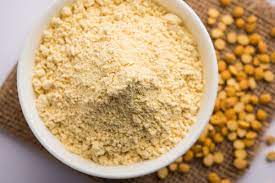ne of our most unhealthy collective eating habits in the West is not having enough fibre in our diets. A diet high in fibre is associated with numerous health benefits, including a decreased risk of heart disease and early death.
You might worry that boosting your intake of fibre through whole foods, including fruit, vegetables, pulses and wholegrains, means having to sacrifice some of your favourite foods. But in recent years, manufacturers have introduced higher fibre alternatives to many of our traditionally low-fibre staples – including pastas, crisps, breakfast cereals and cereal bars. But are they any better than the foods they replace?
It's generally accepted that people should be eating more legumes, including pulses such as lentils and chickpeas, because we don't eat enough fibre. Pulses can help reduce the risk of certain diseases, including type 2 diabetes and heart disease, because we digest them more slowly than other foods, which keeps our blood glucose levels more consistent.
"When you eat a potato, you get a big rise in blood sugar, but legumes have a much lower glycaemic index and insulinemic response," says Peter Ellis, professor of carbohydrate biochemistry at King's College London.
Pulses are also packed with nutrients, and low in fat – although they don't have what researchers call a "complete protein profile". This means that their protein value is lower compared to meat or eggs because they don't contain all the amino acids our body needs. For this reason, experts recommend pairing pulses with wheat, such as pasta.
Another way manufacturers are giving pasta a fibre boost is by replacing some of the flour they traditionally use – usually wheat flour – with flour made from fibre-rich alternatives, including lentils, chickpeas and fava beans.
In 2020, Sophie Saget, a researcher at Trinity College Dublin in Ireland, analysed and compared the nutritional content of pasta made partly with chickpea flour with traditional pasta made with durum wheat flour. She found that the chickpea pasta contained 1.5 times more protein, 3.2 times more fibre and eight times more essential fatty acids.
Eating pasta made with chickpea flour, Saget says, makes it much easier to consume pulses, which she describes as "forgotten heroes". It's also a good way to control how much food we consume, she adds.
"Legumes are a huge source of fibre, and if you eat a lot fibre, you'll feel full faster, so you won't tend to eat more than you need."
But while pulse-based pasta looks like a strong competitor to traditional durum wheat pasta, based on Saget's research, it's unlikely to be a match for whole pulses. This is because of the processing required to make pulses into pasta.
Processing isn't always a bad thing; in a dried state, the nutrients in pulses wouldn't be very bioavailable, says Ellis – but grinding the pulses into flour changes their structure at a cellular level.
"Even if you're eating the whole pulse, the cells containing protein and nutrients separate during the cooking process. But pulse-based pasta takes this processing one step further," he says, as making flour out of pulses involves grinding the dry sediment, which ruptures all the cells.
But there's a lack of research yet on how exactly this changes their nutritional content, Ellis adds, and the exact nutritional profile of a pulse-based pasta will depend on how the pulses are processed, which will vary among manufacturers.
"You're dealing with very complex materials that contain a multitude of different components," he says. "Increasing the concentration of plant foods in your diet is a good thing, but it's right to raise the question of whether pulse-based pastas have any long-term beneficial effects."
The taste test
Like with any other new food product – especially those imitating our favourite foods – the biggest challenge is winning people over with taste and texture. In fact, this is the biggest challenge, says Gunter Kuhnle, professor of nutrition and food science at the University of Reading.
"If something tastes too healthy, people don't like to eat it," he says. "Unless people like it and accept it as a replacement, it won't be successful."
And in that vein, he argues that pulse-based pastas will "probably remain a niche product".
Taste can be influenced by many external factors. For example, knowing that you're eating pasta that defies tradition could be a palette-spoiler. But traditional Italian pasta actually has a history of incorporating pulse flours, says Nick Saltmarsh, managing director of Hodmedods, which produces and sells pulse flours.
When Hodmedods' pasta maker, Giovanni Carleschi, was first tasked with making a pulse-based pasta, he was sceptical.
"But once he realised that there was true Italian pasta using bean flour, he was keen to give it a go," Saltmarsh said.
The end result, using 50% emmer wheat flour and 50% fava bean flour, tastes different to traditional wheat flour – Saltmarsh calls it "distinctive". And having a product that tastes and looks different to its popular counterparts is no easy feat.
"It's a challenge to overcome the preconceptions of what something should taste like when the product is slightly different," says Saltmarsh.
But the product, actually, isn't that different. Italians aren't the only ones to have used pulse-based flour to make pasta – its use is widespread. While pulse-based pasta might seem like a new health fad, we've actually been pushing the health benefits of pulse flours for hundreds of years, says food historian Rebecca Earle.
"People have been making food from chestnut and rice flour for millennia," she says. "And more recently – from around the 18th Century – people in France were advertising flour made from different ingredients, including lentils and haricot beans, as healthier alternatives to traditional flours, which would have been wheat flour, as it is now."
One of the reasons white wheat flour is the most common flour now is because it has become much cheaper over time, thanks to the industrial revolution. Its popularity also partly comes down to its historic association with the upper classes.
"Wheat doesn't have a high yield, so it was expensive in the Middle Ages," Earle says. "And it makes particularly fluffy bread, so it had a high-class quality to it. This meant that, as it became affordable, it was still desirable."
White wheat flour was also considered more nutritious, because it was thought to be better for our digestive systems. However, we now know that higher-fibre alternative flours are generally better for us.
Bringing the past into the present
While pastas made partly with pulse flours might make some pasta fans suspicious, lessons in how they can become more mainstream could soon emerge from a three-year project involving bread made from fava bean flour.
Julie Lovegrove, professor of human nutrition at the University of Reading, has replaced up to 25% of wheat flour with fava flour, which makes it higher in protein, iron, zinc and fibre compared to traditional white bread.
"I imagine that, for pasta, replacing the durum wheat will have a greater nutrient content and lower GI, similar to our substitution with bread," she says.
The Raising the Pulse project involves growing the broad beans and picking ones that are particular iron-rich and nutrient-dense, drying, milling them and then working with bakers to produce the final product – which will then be tested out across a university campus.
"We want the bread to be as identical as possible to commercial white bread so that people can consume it without changing their eating habits," she says.
"Scientists can develop foods with high amounts of pulses, but if people don't like the taste, it's just an academic exercise," she says. "It'd be amazing for pulse-enriched bread to be the norm, but we've got to make sure it's accessible and acceptable for people."
The health benefits of adding pulse-based pasta to your diet really depend on what you're eating it instead of. When it comes to processed plant-based foods, pulse-based pasta is a relatively good choice, says Saget.
"Compared to a legume-based burger, for example, legume pasta is relatively low processed," she says.
Despite a lack of research into pulse-based pastas, the wealth of evidence on the health benefits of pulses suggests that swapping pulses and other whole foods for pulse-based pasta won't be as beneficial to our health as using it as an alternative to regular wheat pasta.
More about:
















































